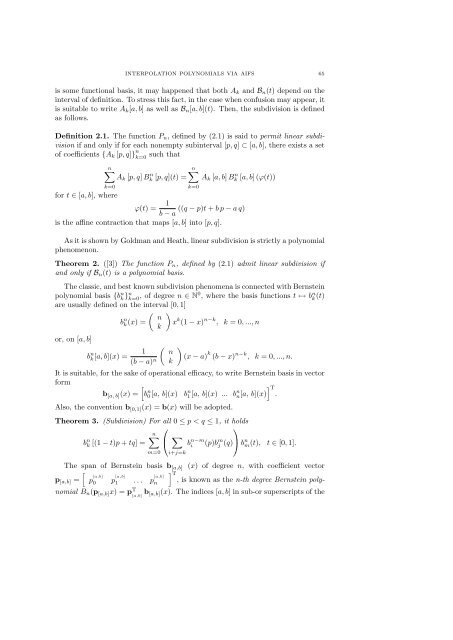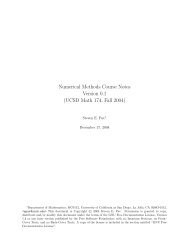Skopje, Makedonija INTERPOLATION POLYNOMIALS VIA AIFS 1 ...
Skopje, Makedonija INTERPOLATION POLYNOMIALS VIA AIFS 1 ...
Skopje, Makedonija INTERPOLATION POLYNOMIALS VIA AIFS 1 ...
Create successful ePaper yourself
Turn your PDF publications into a flip-book with our unique Google optimized e-Paper software.
<strong>INTERPOLATION</strong> <strong>POLYNOMIALS</strong> <strong>VIA</strong> <strong>AIFS</strong> 65<br />
is some functional basis, it may happened that both A k and B n (t) depend on the<br />
interval of definition. To stress this fact, in the case when confusion may appear, it<br />
is suitable to write A k [a, b] aswellasB n [a, b](t). Then, the subdivision is defined<br />
as follows.<br />
Definition 2.1. The function P n , defined by (2.1) is said to permit linear subdivision<br />
if and only if for each nonempty subinterval [p, q] ⊂ [a, b], there exists a set<br />
of coefficients {A k [p, q]} n k=0<br />
such that<br />
n∑<br />
n∑<br />
A k [p, q] Bk n [p, q](t) = A k [a, b] Bk n [a, b](ϕ(t))<br />
k=0<br />
k=0<br />
for t ∈ [a, b], where<br />
ϕ(t) = 1 ((q − p)t + bp− aq)<br />
b − a<br />
is the affine contraction that maps [a, b] into[p, q].<br />
As it is shown by Goldman and Heath, linear subdivision is strictly a polynomial<br />
phenomenon.<br />
Theorem 2. ([3]) The function P n , defined by (2.1) admit linear subdivision if<br />
and only if B n (t) is a polynomial basis.<br />
The classic, and best known subdivision phenomena is connected with Bernstein<br />
polynomial basis {b n k }n k=0 ,ofdegreen ∈ N0 , where the basis functions t ↦→ b n k (t)<br />
are usually defined on the interval [0, 1]<br />
( )<br />
b n n<br />
k(x) = x k (1 − x) n−k , k =0, ..., n<br />
k<br />
or, on [a, b]<br />
b n k[a, b](x) =<br />
1<br />
(b − a) n (<br />
n<br />
k<br />
)<br />
(x − a) k (b − x) n−k , k =0, ..., n.<br />
It is suitable, for the sake of operational efficacy, to write Bernstein basis in vector<br />
form<br />
[<br />
T.<br />
b [a, b] (x) = b n 0 [a, b](x) b n 1 [a, b](x) ... b n n[a, b](x)]<br />
Also, the convention b [0,1] (x) =b(x) will be adopted.<br />
Theorem 3. (Subdivision) For all 0 ≤ p














